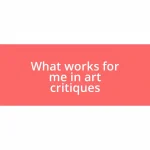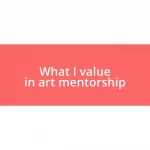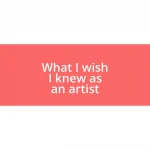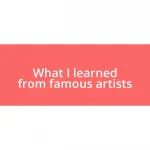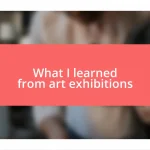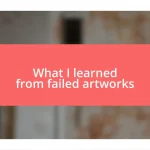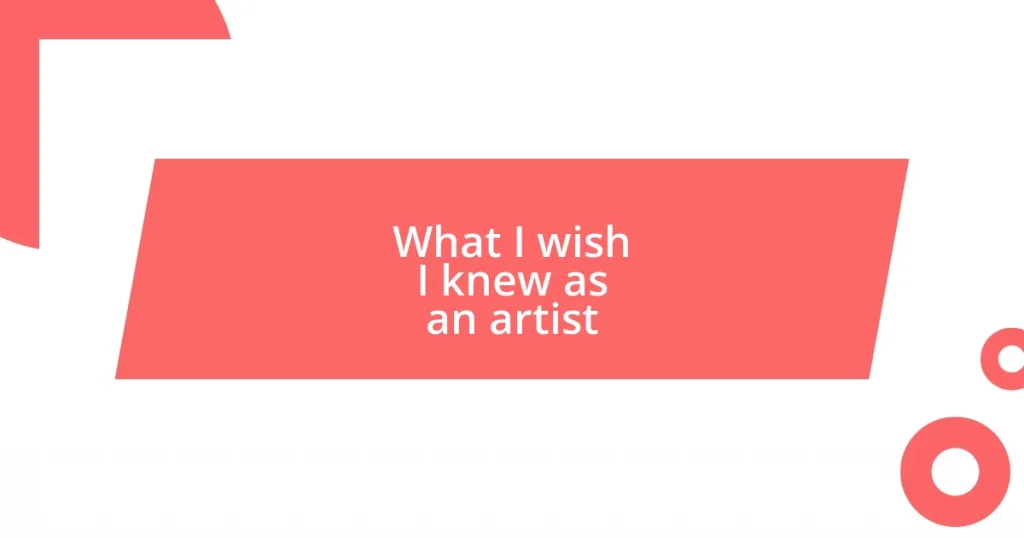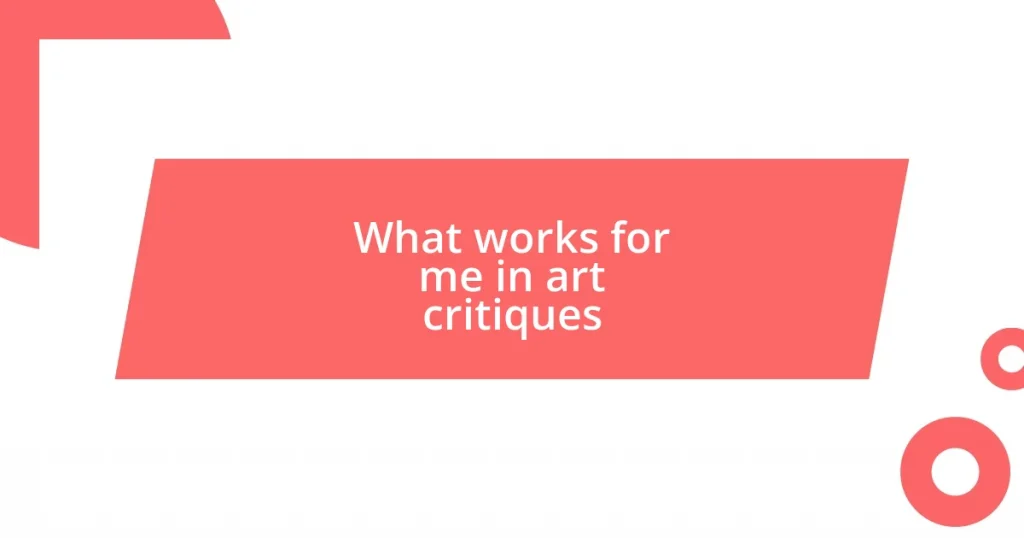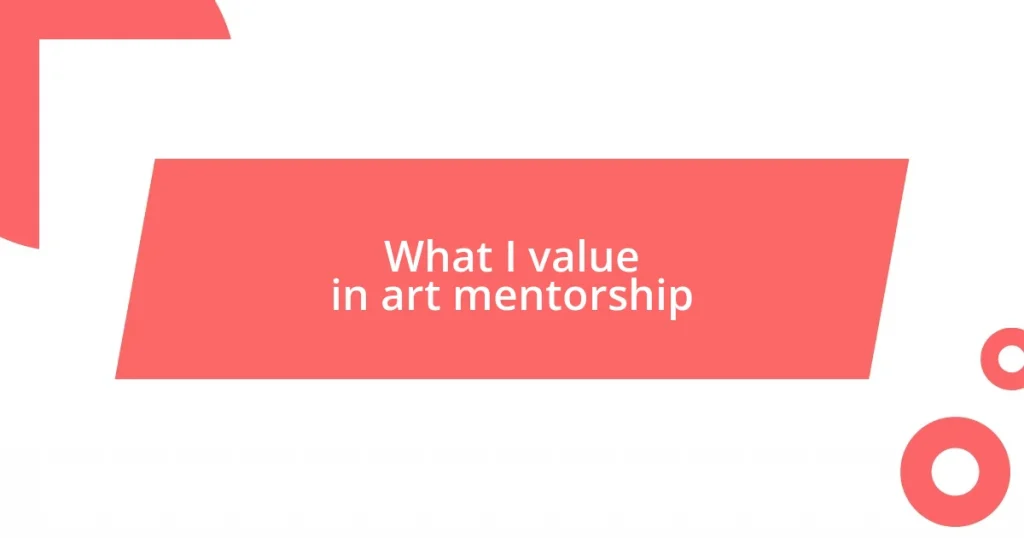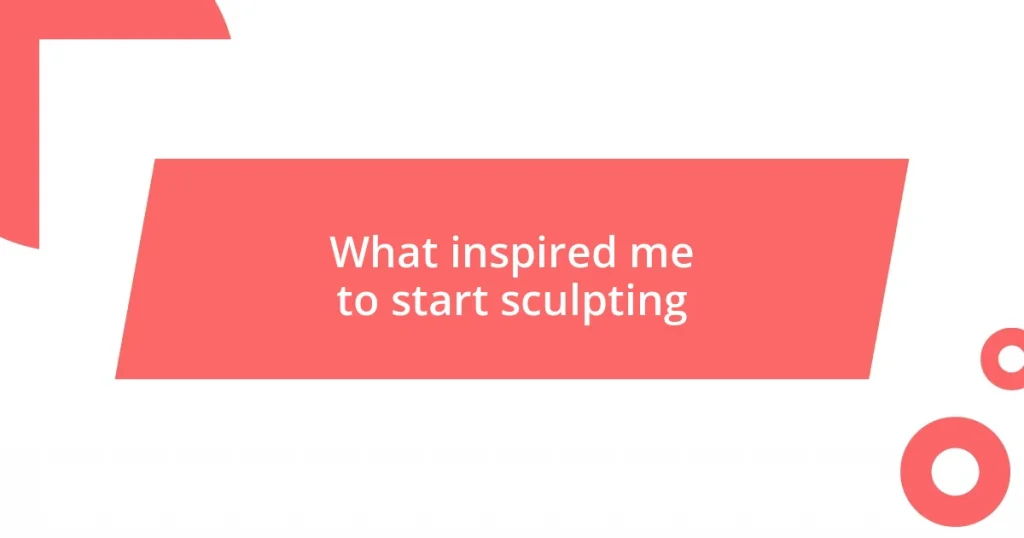Key takeaways:
- Embrace both highs and lows in your artistic journey; they are essential for growth and self-discovery.
- Developing a unique style requires experimentation, patience, and the willingness to seek feedback from others.
- Learning the business side of art—such as pricing, marketing, and financial management—is crucial for sustainability and success as an artist.
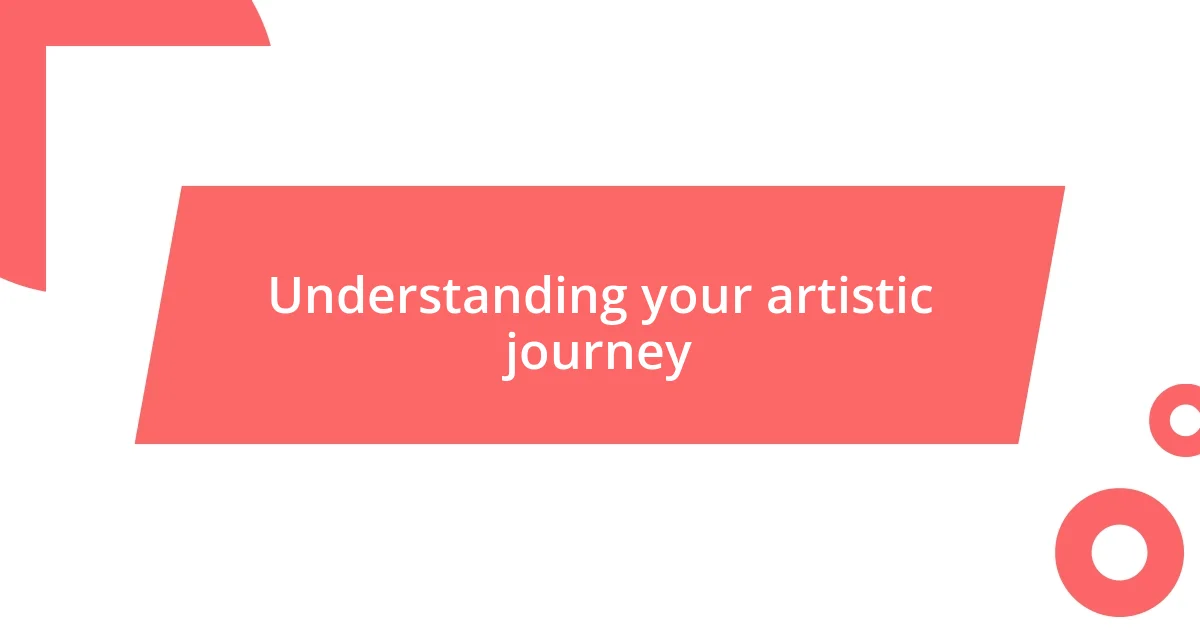
Understanding your artistic journey
Understanding your artistic journey is deeply personal and uniquely yours. I remember the early days of my artistic exploration, when I struggled to find my style. I often found myself wondering, “Is there a right way to express my creativity?” My answer became clear over time: there isn’t. Each twist and turn in my journey has shaped my voice, often leading me to unexpected places.
I once hit a significant roadblock where my inspiration seemed to vanish. In that moment of self-doubt, I learned that these lows are as vital as the highs. They force us to reevaluate our motivations and push beyond our comfort zones. Have you ever felt stuck in your process? I believe that embracing those difficult moments can pave the way for incredible growth and newfound creativity.
Your journey may include influences from mentors or the community around you. Reflecting on my experiences, the connections I built often sparked new ideas and directions. It’s essential to surround yourself with diverse perspectives, as they can ignite the passion and possibilities that lie within. Surrounding yourself with the right people not only deepens your understanding of art but also reinforces the importance of collaboration in our artistic evolution.
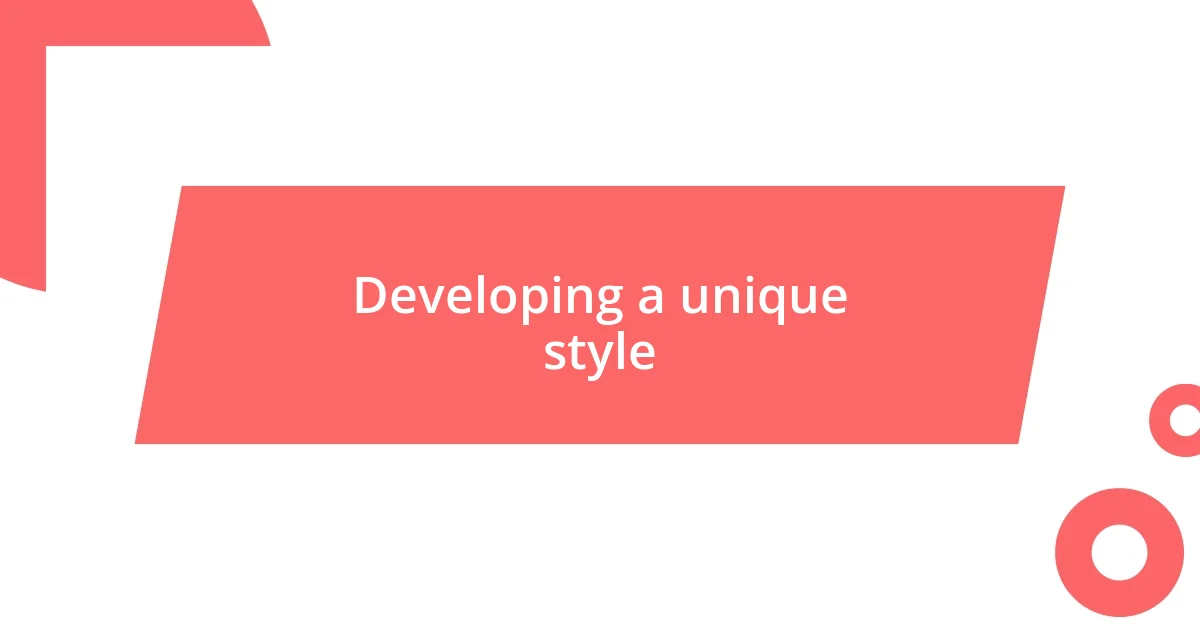
Developing a unique style
Finding a unique style as an artist can feel like an elusive quest. I recall spending hours experimenting with different mediums, from acrylics to digital art, often frustrated by the results. It wasn’t until I let go of the pressure to conform to others’ standards that I began to discover what resonated with me. The moment I embraced my quirks—like my love for bold colors and unusual shapes—was when my work truly began to reflect who I am.
To help you navigate this journey, consider these key points:
- Experiment Freely: Allow yourself to create without the fear of judgment. Try different styles, techniques, or subjects.
- Identify Influences: Think about what pieces or artists inspire you. Analyze what aspects you’re drawn to and why.
- Keep a Sketchbook: Jot down ideas, doodles, or notes that inspire you. This will become a valuable resource for your artistic exploration.
- Seek Feedback: Share your work with trusted friends or mentors who can offer constructive criticism and support.
- Be Patient: Developing a unique style takes time. Embrace the process and trust that your style will evolve.
Remember, it’s not just about the end product but the journey of self-discovery along the way. I find that the more I embrace my own narrative, the more authentic and engaging my art becomes.
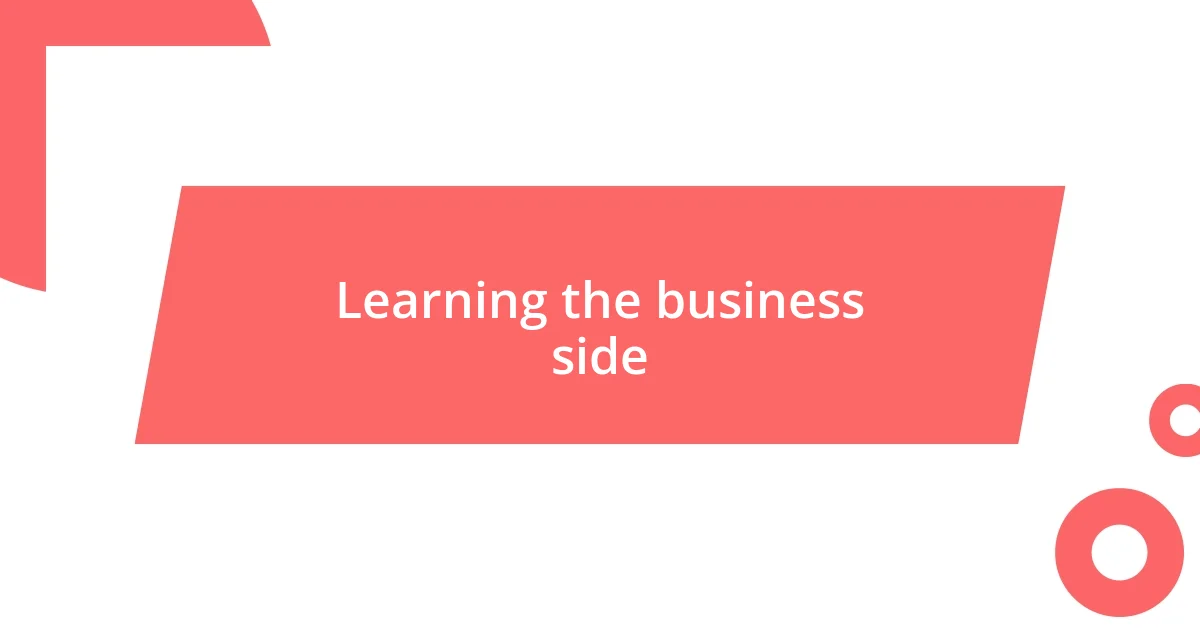
Learning the business side
Learning the business side of being an artist can be just as crucial as honing your craft. I remember when I first started selling my work. The excitement of showcasing my art was quickly met with the reality of pricing, contracts, and marketing. I never anticipated that understanding the logistics—like how to calculate costs and set prices—would be such a daunting part of my journey. But grasping these concepts not only empowered me financially but also gave my art a professional edge.
Sales and marketing might not seem appealing at first, but they’re vital for an artist’s success. I vividly recall attending my first art fair, filled with anticipation but also a sense of dread. I realized that I needed to actively engage with potential buyers, share the stories behind my pieces, and build genuine connections. The more I invested in learning how to effectively market my work—through social media, networking, and building a mailing list—the more my audience grew.
Beyond just selling art, keeping track of expenses and understanding taxes was a game-changer. At first, I neglected to save my receipts and manage my income, which led to a chaotic tax season. Now, I keep a detailed ledger and even use software to help. This simple shift has made a tremendous difference in treating my art as a business, rather than just a hobby. Have you taken time to learn about the business aspects of your craft? Trust me, it’s an invaluable investment in your artistic future.
| Business Aspect | Importance |
|---|---|
| Pricing | Ensures your work is valued and supports sustainability. |
| Marketing | Helps you reach a broader audience and create lasting connections. |
| Financial Management | Streamlines your business dealings and keeps your creative metier thriving. |
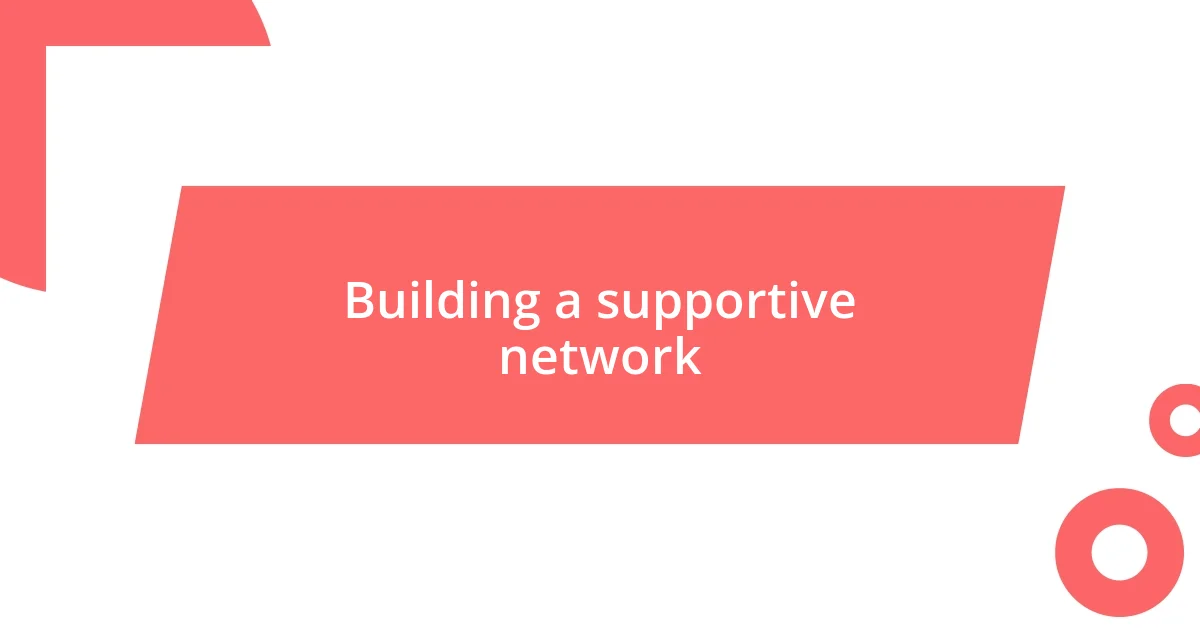
Building a supportive network
Building a supportive network is one of the most transformative steps I took as an artist. I still remember my first art workshop, where I felt a mix of excitement and nervousness. That initial connection with fellow creatives opened my eyes to the power of community; we shared ideas, struggles, and encouragement that I truly needed. Looking back, I realize how pivotal that experience was in shaping my artistic journey.
When I began reaching out for collaboration, I discovered that many artists are eager to help each other. For example, after posting my work on social media, a local artist invited me to join her studio for a collaborative project. This not only expanded my skill set but also deepened my understanding of different perspectives in art. Have you ever considered how these collaborations could enhance your own creativity? It’s like a refreshing spark that keeps the artistic fire alive.
Building genuine relationships with mentors is a game-changer too. I found that my most valuable advice came from seasoned artists who had navigated the same challenges I faced. I recall a late-night conversation with a mentor over a cup of coffee. She shared her journey of overcoming self-doubt, and her openness made me feel less alone in my fears. Each connection I made added layers to my network, reminding me that we all face similar hurdles, and we can lift each other up along the way.
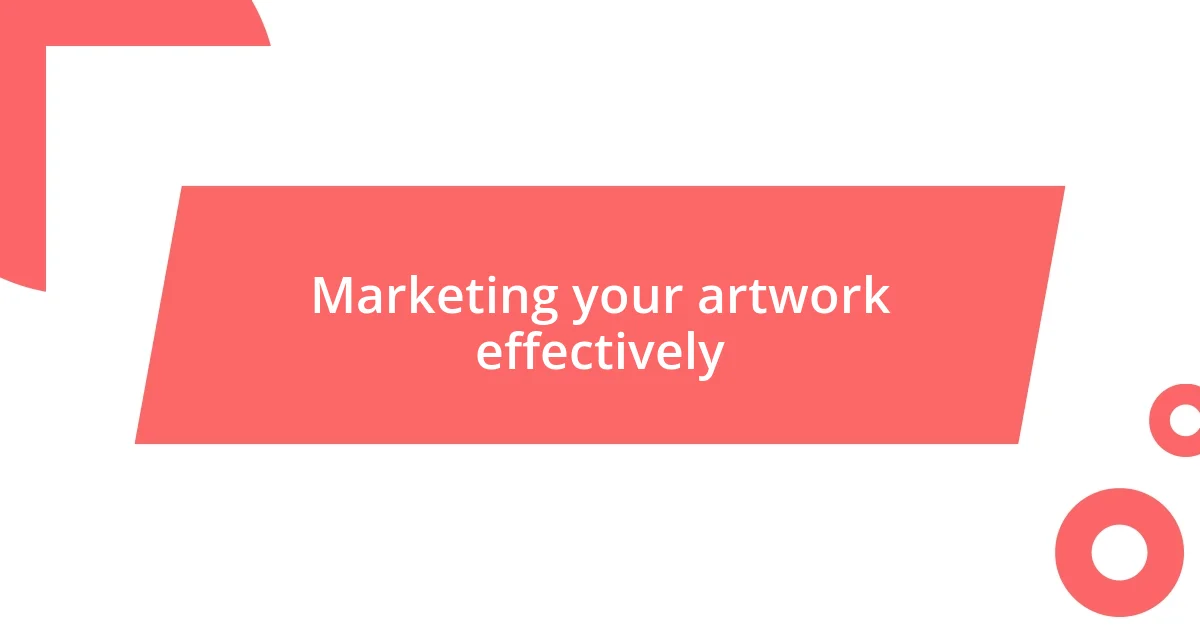
Marketing your artwork effectively
Marketing your artwork effectively often feels like a labyrinth, but it’s essential for any artist serious about their craft. I remember the first time I posted my art online—my heart raced with hope, but I was met with silence. It was a crucial lesson in understanding that just sharing my work wasn’t enough; I needed to actively engage with my audience. Have you ever tried to spark conversation around your pieces? I found that asking followers about their interpretations led to unexpected dialogues that not only increased visibility but also deepened my connection with them.
Developing a consistent brand made a world of difference for me, too. I once experimented with varying styles and mediums, but it left my audience confused about who I was as an artist. Finding a cohesive voice helped my work resonate more effectively with viewers. Now, when I curate my social media posts or website, I ensure that each piece reflects my unique style and story. Have you thought about how your brand identity impacts daily sales? Trust me, a clear identity can turn those once-nervous encounters with potential buyers into meaningful interactions.
Lastly, I can’t stress enough the importance of storytelling in marketing. One day, while prepping for an exhibition, I shared the backstory of the artwork I was showcasing—how it was inspired by a transformative trip I took years ago. That simple act of vulnerability led to unexpected conversations that not only drove sales but also created lasting relationships. Have you considered what stories your art tells? Embracing your personal narrative can transform the way people connect with your work, making it far more than just a transaction.
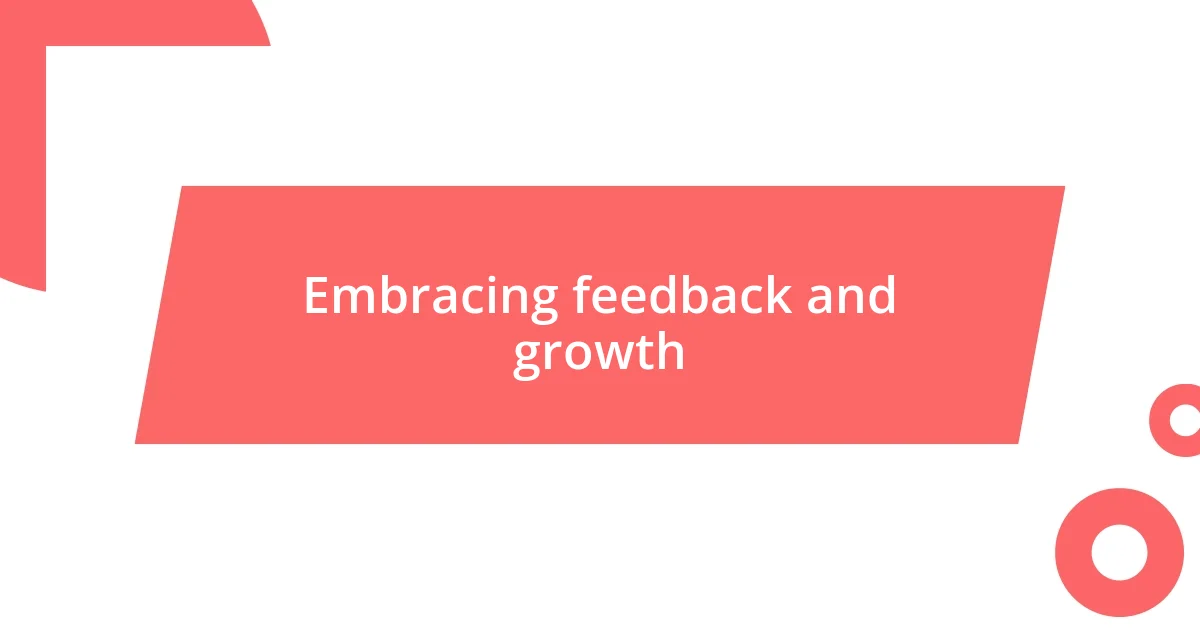
Embracing feedback and growth
I used to dread feedback, viewing it as a critique of my talent rather than an opportunity for growth. However, one day after a gallery show, a fellow artist offered me some constructive criticism on my color choices. Initially, I felt a sting of defensiveness—until I realized her insights illuminated aspects of my work I had never considered. Have you ever turned a blind eye to criticism? That moment taught me that genuine feedback can spark the evolution of my style in unexpected and exciting ways.
Receiving feedback isn’t just about the comments; it’s about the mindset I adopted. I started approaching critiques with a sense of curiosity rather than fear. I remember a workshop where the instructor encouraged us to view feedback as a collaborative tool instead of a judgment. That shift in perspective felt liberating; I began to actively seek out opinions from diverse voices in the art community. How about you? Have you tapped into the collective wisdom of others to refine your craft?
Growth stems from the willingness to embrace discomfort, and this has become a cornerstone of my journey. I once attended a critique group where I felt vulnerable sharing my latest pieces. Listening to others voice their interpretations made me realize that art is often an invitation for dialogue. It allowed me to see the emotional depths of my work, revealing connections with viewers I had not anticipated. Why not take that leap? Stepping outside my comfort zone has repeatedly proven to be a catalyst, pushing my artistry to new heights.
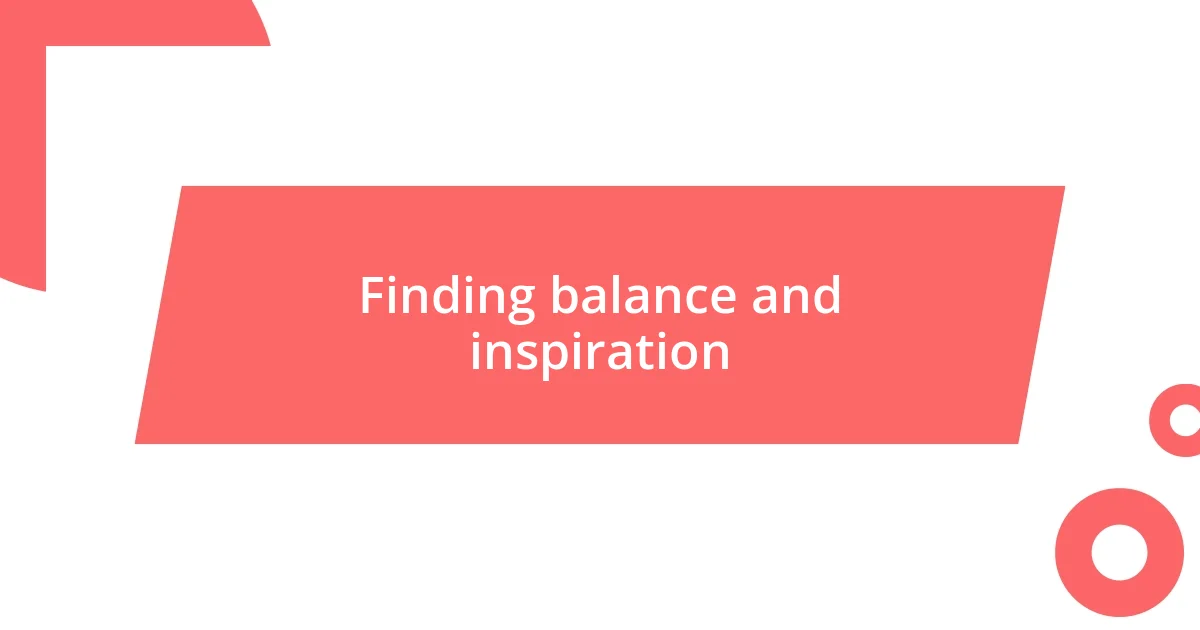
Finding balance and inspiration
Finding inspiration is often a delicate balancing act. I remember a time when I felt completely burnt out, pushing myself to create when all I produced felt lackluster. It dawned on me that stepping away wasn’t a sign of weakness but rather a way to recharge my creative batteries. Have you ever taken a break only to find a flood of ideas rush back as soon as your mind is at ease? I learned that finding balance between work and rest is crucial for keeping my inspiration alive.
Maintaining a rhythm between my artistic practice and my personal life was a game-changer. I started scheduling blocks of time not just for painting, but for exploring nature or diving into new books. One day, while hiking through the woods, I stumbled upon a vibrant sunset that ignited a new color palette in my mind. Isn’t it interesting how inspiration can strike in the most unexpected moments? I realized that nurturing my curiosity about the world directly informs my art, making it richer and more varied.
Lastly, I often struggled with the notion of inspiration being a constant fuel. I had to accept that some days would feel more inspiring than others, and that’s okay. I recall a week where I felt stuck, until I decided to visit a local art museum. Surrounded by the artwork of others, I found my perspective shifting. Do you think a change of scenery can breathe new life into your creativity? For me, it reinforced my belief that inspiration is not an isolated experience—it’s a continuous exchange between the world around us and the emotions within us.
